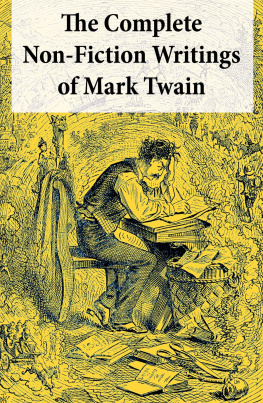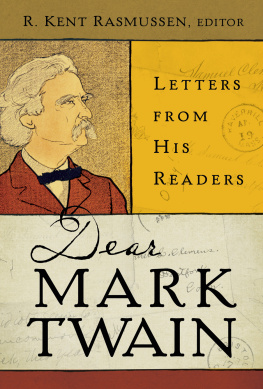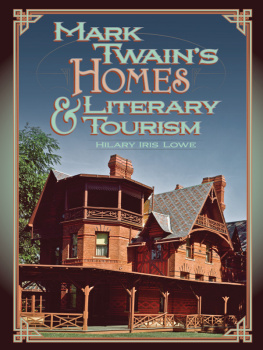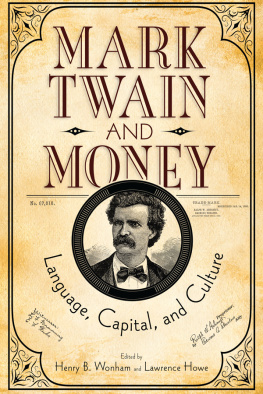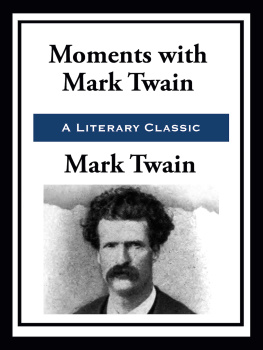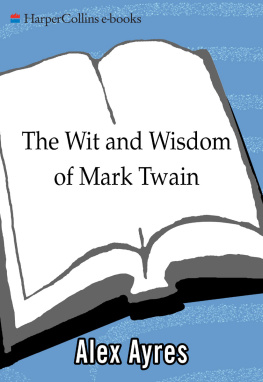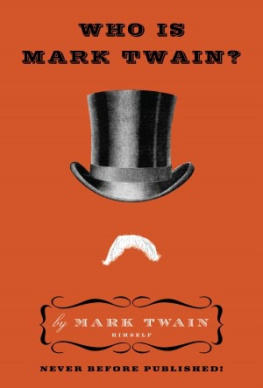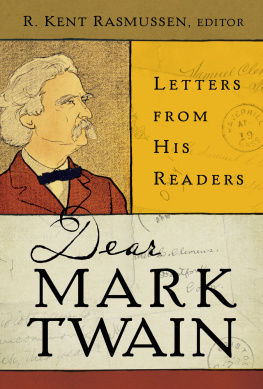Acknowledgments
This book would not exist without the gift of time and generous institutional support. I would like to thank the National Endowment for the Humanities for awarding me a yearlong faculty research fellowship; the University of Saint Joseph for sabbatical leave; and the Elmira College Center for Mark Twain Studies for several residencies at the quietest of all quiet placesthe writers beloved summer home, Quarry Farm.
I am deeply indebted to the Mark Twain Papers and Project at the University of California, Berkeley, where the majority of this research was conducted. Bob Hirst, the projects general editor, fielded my incessant questions with patience and unfailing good cheer. His vast knowledge of Twains life and work was integral to interpreting the documentary evidence that undergirds my analysis. Several of the projects other editorsVic Fischer, Ben Griffin, and Harriet Elinor Smithalso provided valuable assistance, as did reference and administrative manager Melissa Martin, whose pleasant, efficient demeanor in responding to requests large and small set a very high bar indeed. In addition, the curatorial staff at the archives of Hartfords Mark Twain House & Museum, Tracy Brindle and Mallory Howard, along with former chief curator Patti Philippon, were instrumental in helping me unravel the mystery surrounding the Maori artifacts acquired by the Clemens family during the 189596 world lecture tour. I would also like to acknowledge the extraordinary efforts of Kathy Kelley, the University of Saint Josephs interlibrary loan librarian, in tracking down the many obscure sources I requested over the past decade.
I am likewise deeply grateful to a number of individuals in New Zealand and Australia, who generously responded to my cold queries, often directing me to friends and associates if they themselves didnt have the information I was seeking: Anna K.C. Petersen and Donald Kerr of the Hocken Collections at the University of Otago; Dimitri Anson, Department of Anthropology, University of Otago; Roger Fyfe, senior curator of human history at Christchurchs Canterbury Museum; Geraldine Lummis, who kindly shared her masters thesis on Joseph Kinsey with me; Allan Smith, secretary of the Christchurch Savage Club; Paul Moon, senior lecturer in Maori studies at the Auckland University of Technology; and Joanne Huxley, research officer at the Tasmanian Museum and Art Gallery. Their assistance was invaluable in piecing together the hidden details of Twains transformative visit to the land down under.
Closer to home, a number of people merit special recognition for bringing relevant archival information to my attention: Barb Schmidt, the creator of twainquotes.com, who shared numerous articles she recovered from the digitized databases of various nineteenth-century newspapers; Twain collector Kevin MacDonnell, who provided me with the Christies auction catalog describing the writers marginalia in Richard Irving Dodges Our Wild Indians; Larry Berkove, who generously gifted me with a trove of microfilmed Dan DeQuille sketches hed spent years assembling; and Mark Woodhouse, former curator of the Mark Twain Archives at Elmira College, for tracking down details concerning the September 1884 performance of Buffalo Bills Wild West at the Elmira Driving Park. Their contributions prove that it takes a village, not only to raise a child, but also to write a book.
In the course of this projects long gestation, numerous colleagues read draft chapters and offered strategic suggestions: Steve Courtney, whose unerring journalistic eye was quick to flag overblown academic jargon and bring my prose back down to earth; Bob Hirst; Sharon McCoy; Bruce Michelson; Ann Ryan; and Barb Schmidt. Neil Schmitz, my former dissertation director at SUNY-Buffalo, believed in the importance of this project early on and expressed his support throughout. I owe a particular debt of gratitude to Julius Rubin at the University of Saint Joseph, with whom I team taught a series of honors capstone seminars on Native American history and literature. Julius taught me a great deal about native peoples and generously shared books from his expansive personal library; over hours of conversation at Starbucks, he also listened intently and helped shape my argument by asking probing, insightful questions. When I had moments of doubt and frustration, he convinced me to persevere.
Many long-time friends in the Mark Twain Circle sustained me through their personal encouragement, chief among them Ann Ryan, John Bird, Tom Quirk, and the late Michael J. Kiskis. Barbara Snedecor, the emerita director of Elmira Colleges Center for Mark Twain Studies, deserves special thanks for the warmth of her steadfast assurance. I am above all grateful for the enduring support of my familymy husband, Dan, and dearest sons, Liam and Austin.
Abbreviations
ARCHIVES
Berg | Berg Collection, New York Public Library |
MTP | Mark Twain Papers, University of California, Berkeley |
TKC | Thomson-Kinney Collection, Connecticut State Library Archives |
BOOKS
A1 | Autobiography of Mark Twain, vol. 1 |
A2 | Autobiography of Mark Twain, vol. 2 |



